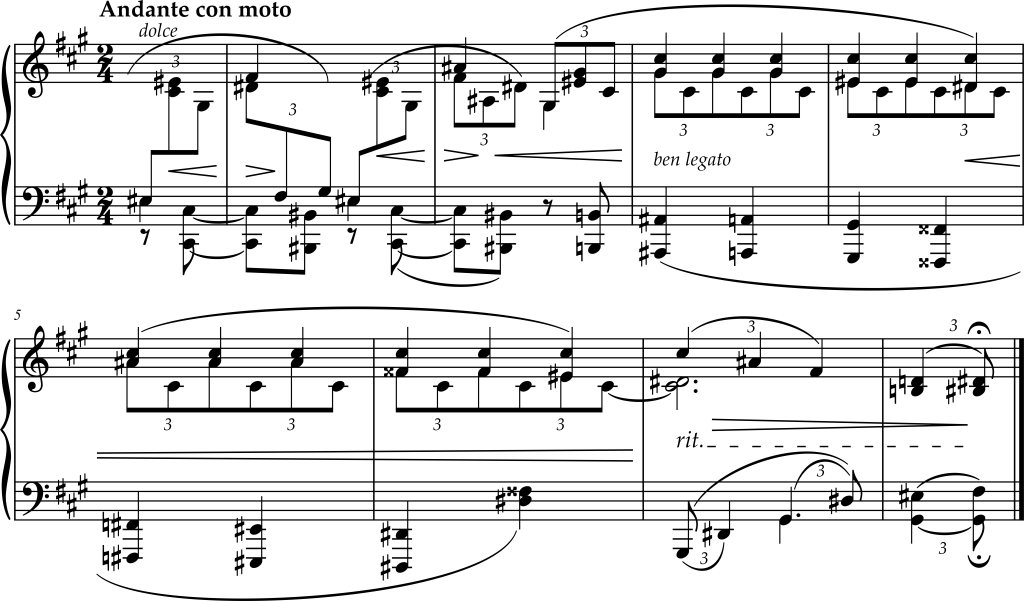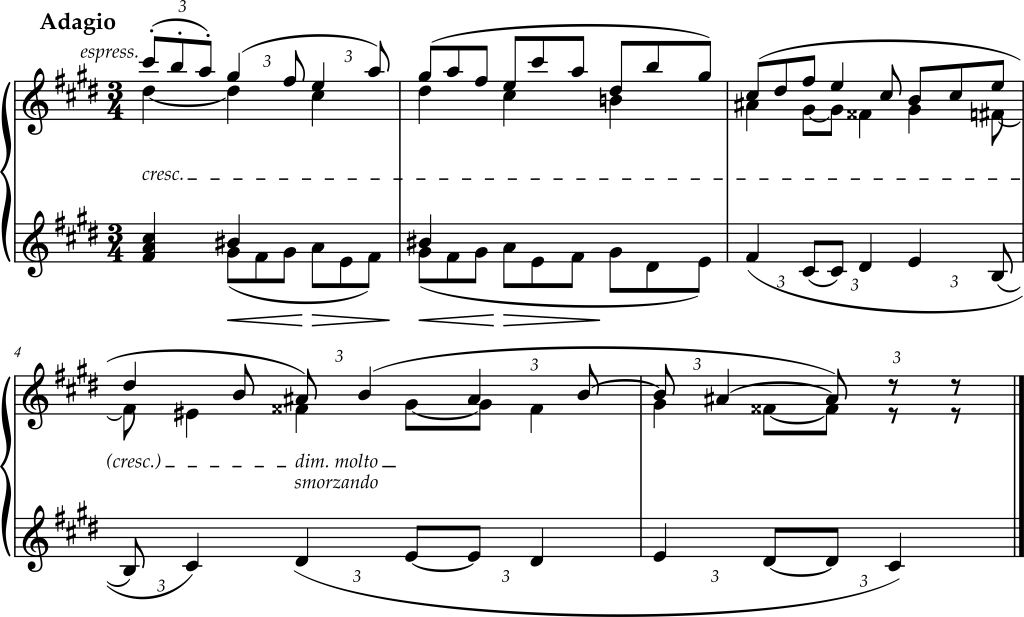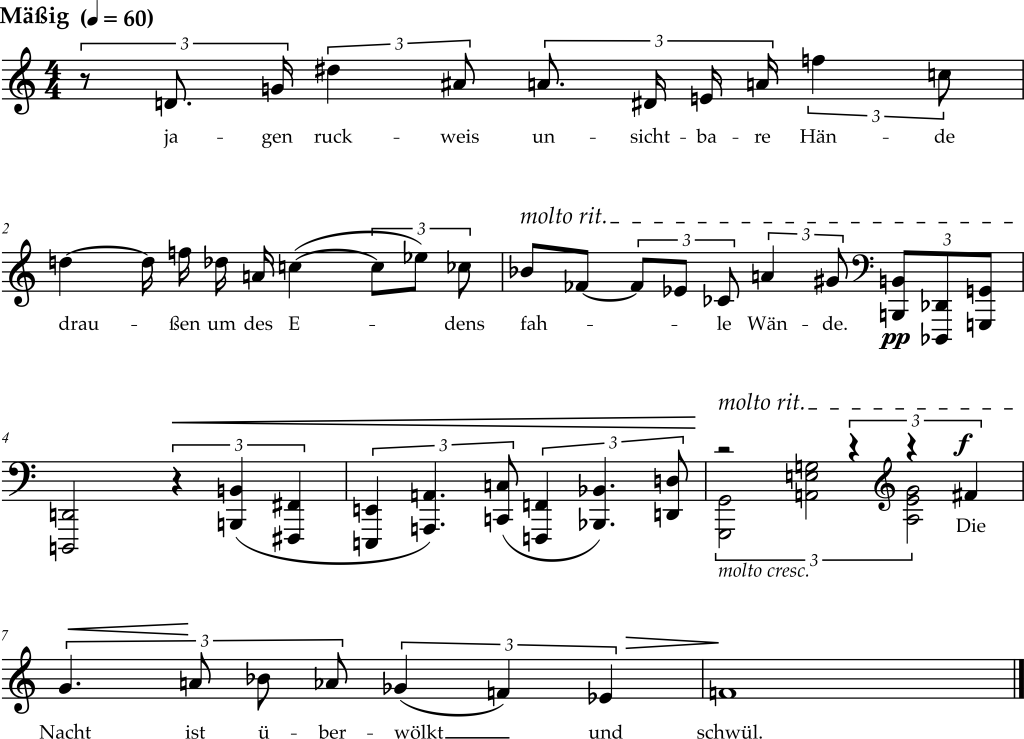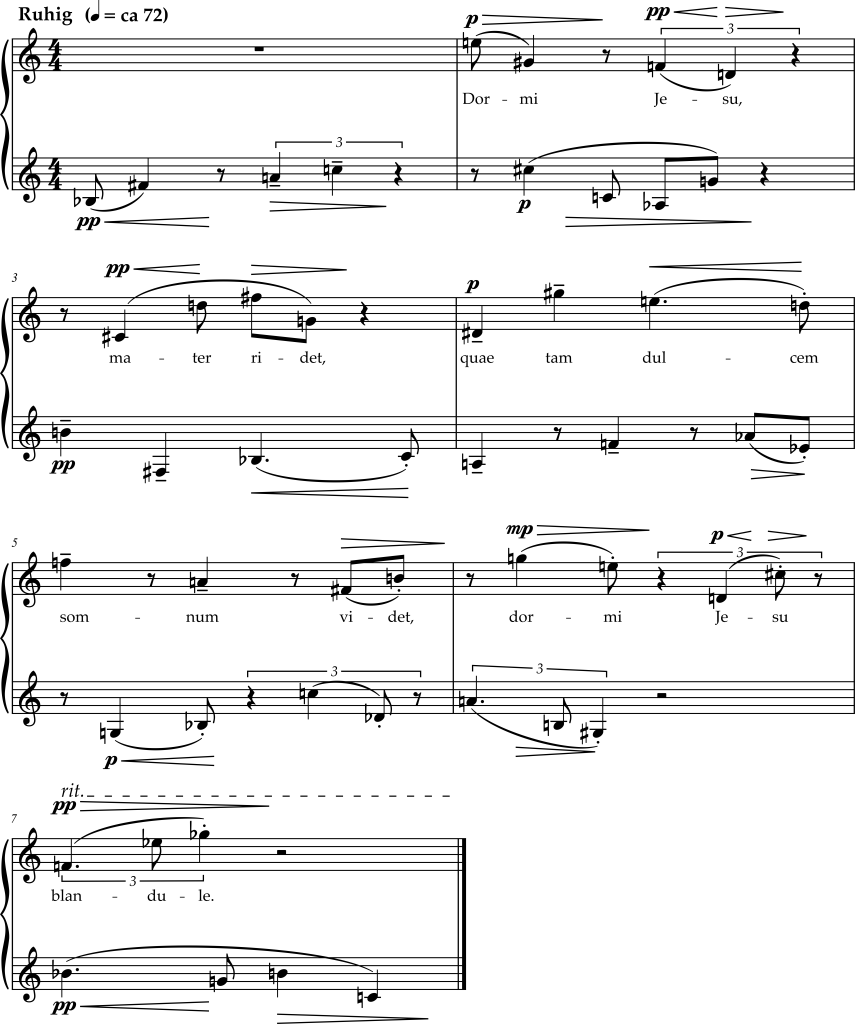A. Large-Value Triplets and Three-Against-Two
Four Guided Examples
Performing large-value triplets is a two-step process. First, one must establish accurate and even single-beat triplets. Then, one must regroup these triplets into pairs. Exercise 5A-1 makes this regrouping explicit. The right hand initially moves in single-beat, eighth-note triplets. These are superimposed against the left hand in a single-beat, three-against-two pattern. In the third measure, eighth-note triplets continue in the right-hand inner voice (stems down), while an upper voice (stems up) regroups them from sets of three to sets of two. This regrouping produces large-value, quarter-note triplets and a large-value, three-against-two pattern with the left hand’s quarter notes. In the penultimate measure, the right-hand inner voice stops, but the triplet quarters of the upper voice continue.
Exercise 5A-1: Johannes Brahms, Intermezzo, Opus 76, Number 6

The challenge is take the process that is composed out over several measures in Exercise 5A-1 and turn it into an instantaneous mental process. We recommend working up to that skill as follows. Start with the top line of Exercise 5A-1, tapping or conducting the quarter-note beat. In the top line, give extra accentuation to the quarter-note beat in the first two measures, and then reorient those accents to the quarter-note triplets in the next four measures. Then, moving into the penultimate measure, take mental note of how only the accents are sustained. Once this is mastered, incorporate the rhythmic patterning of the left hand.
After this process is mastered in Exercise 5A-1, move to Exercises 5A-2, 5A-3, and 5A-4, which make gradually less explicit the single-beat triplets that provide the scaffolding for large-value triplets, in turn demanding that the performer provide that scaffolding mentally. For Exercise 5A-2, first imagine eighth-note triplets while sustaining the opening, low Eb in order to facilitate the opening triplets. Then, mentally switch to a duple subdivision of the beat (eighth notes) while sustaining the C to facilitate the subsequent rhythmic patterning. Then, on the long G, mentally switch back to eighth-note triplets to set up the quarter-note triplets of the next few measures. Then, at the onset of measure 5, imagine articulating only every other eighth-note triplet to produce the quarter-note triplets. The last step is analogous to how Exercise 5A-1 moves into its penultimate measure.
Exercise 5A-2: Richard Strauss, Ein Heldenleben

For Exercise 5A-3, imagine a duplet division of the beat at the beginning to facilitate the opening rhythmic gesture. Then, on the sustained C#, imagine eighth-note triplets to set up the quarter-note triplets in the second measure, similar to the exercise above. The difference here is that no eighth-note triplets are explicit in the music prior to the triplet-quarters––the performer must supply them mentally. Practice measure 2 by first removing the C# tie and then adding it back in.
Exercise 5A-3: Arnold Schoenberg, Book of the Hanging Gardens, “Wir bevölkerten die abendüstern Lauben”

Unlike the exercises above, in Exercise 5A-4 there is no sustained note between the dotted pattern and the subsequent triplet quarters that might give the performer time to mentally establish and regroup eighth-note triplets. Instead, this process of mental subdivision and regrouping must happen instantaneously at the start of quarter-note triplets.
Exercise 5A-4: Arnold Schoenberg, Book of the Hanging Gardens, “Wir bevölkerten die abendüstern Lauben”

Once Exercises 5A-1 through 5A-4 have been practiced and mastered in the ways described above, the basic skill for performing large-value triplets and 3:2 is in place and simply needs to be practiced in a variety of contexts, which the examples below provide. Remember throughout that accurate performance of large-value triplets requires sustained mental effort on the part of the performer, who must mentally switch back and forth between duple and triple divisions of the beat at a moment’s notice in order to facilitate upcoming rhythmic patterning.
Examples for Application
Exercise 5A-5: Claude Debussy, String Quartet, Opus 10, Movement 1
[Coming soon!]
Exercise 5A-6: Johannes Brahms, Intermezzo, Op. 116, Number 4

Exercise 5A-7: Arnold Schoenberg, Book of the Hanging Gardens, “Wir bevölkerten die abendüstern Lauben”

Exercise 5A-8: Richard Strauss, Also sprach Zarathustra
[Coming soon!]
Large-Value Triplets with Nested Rhythms
Exercise 5A-9: Heitor Villa-Lobos, Amazonas
[Coming soon!]
Exercise 5A-10: Arnold Schoenberg, Book of the Hanging Gardens, “Wir bevölkerten die abendüstern Lauben”

Exercise 5A-11: Anton Webern, Five Canons, Opus 16, Number 2


